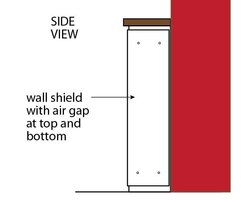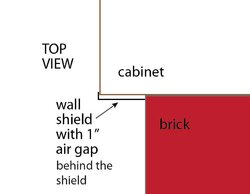Morning. Ed, here, from down in hot, muggy, humid, south central Alabama about 60 miles south of Montgomery. Before I head outside to mow the grass this morning (in the man killing, tree wilting humidity/heat) I thought I'd post this message so maybe some of ya'll could be chewing over it while I'm sweatin' and swatting horseflies. I'm not sure where to start so I'll give you some background information, current information, wants/desires/wishes/fantasies, and a couple of pictures.
As mentioned above I'm located in south central Alabama and I'm hoping to install a wood burning appliance within the next couple of months. We have an old existing fireplace that we would like to incorporate into the wood heating. To the best of my knowledge there has never been a fire built in the fireplace unless it was immediately after the house was built. There was two non-working propane floor-furnaces in the house, one was removed to use as a return for our geothermal system. As I recall, these furnaces vented into the chimney from the back. I've included pictures of the fireplace showing dimensions. One dimension not shown is the throat (which is blocked with some rigid insulation that I installed some 20 years ago), the throats rough dimensions are 30"x8".
The house is brick and was built around 1950 and has lots of GIANT leaky single-pane windows in it. Heated area is ~1830 square feet. We currently heat/cool with the 5-ton geothermal unit which does a good job (no "emergency" heat strips installed)...except in times of power outages. Even though the geothermal system is energy efficient it still makes those electron$ spin the meter thus wearing out those precious bearings in it...and I'm *really* concerned about the wear on those shiny little pearls.
Anyhow, I would really like to at least supplement the geothermal heating with wood heat to lower the electricity bill....doing away completely with the dependency on electricity for heat would be great but not necessarily the goal, and I like the idea of a backup heating system.
For some reason I'm drawn to the Jotul line of stoves/inserts. Jotul seems to be a quality product and non-catalytic is a biggie for me. It appears, though, that Jotul carries a premium price. If there's another brand that would equal the Jotuls but maybe less expensive that would be great...I don't necessarily need an alligator on my shirt (but, I really do like those Jotuls ).
).
The measurements in the pictures are for figuring out (of course) what will fit. The stoves that I'm looking eyeballing strongly are the F3CB and the Castine. I'm looking at the two smaller Jotul inserts.
I have a question here...with an insert, if the power goes out how well do they heat with the blowers not working? Seems the stoves would definitely have an edge over the inserts.
One last thing, and I'll be quiet...does either the Castine or the F3CB have the ability to be used as a cooktop for maybe frying up bacon and eggs?
Well, that's about all of my uneducated mutterings this morning. I really would appreciate some feedback...I need all the help that I can get as it seems there is an absence of wood stove stores down my way.
Take care (anybody wanta come mow my grass for me?),
Ed



ETA: Added picture of chimney top, FWIW
As mentioned above I'm located in south central Alabama and I'm hoping to install a wood burning appliance within the next couple of months. We have an old existing fireplace that we would like to incorporate into the wood heating. To the best of my knowledge there has never been a fire built in the fireplace unless it was immediately after the house was built. There was two non-working propane floor-furnaces in the house, one was removed to use as a return for our geothermal system. As I recall, these furnaces vented into the chimney from the back. I've included pictures of the fireplace showing dimensions. One dimension not shown is the throat (which is blocked with some rigid insulation that I installed some 20 years ago), the throats rough dimensions are 30"x8".
The house is brick and was built around 1950 and has lots of GIANT leaky single-pane windows in it. Heated area is ~1830 square feet. We currently heat/cool with the 5-ton geothermal unit which does a good job (no "emergency" heat strips installed)...except in times of power outages. Even though the geothermal system is energy efficient it still makes those electron$ spin the meter thus wearing out those precious bearings in it...and I'm *really* concerned about the wear on those shiny little pearls.
Anyhow, I would really like to at least supplement the geothermal heating with wood heat to lower the electricity bill....doing away completely with the dependency on electricity for heat would be great but not necessarily the goal, and I like the idea of a backup heating system.
For some reason I'm drawn to the Jotul line of stoves/inserts. Jotul seems to be a quality product and non-catalytic is a biggie for me. It appears, though, that Jotul carries a premium price. If there's another brand that would equal the Jotuls but maybe less expensive that would be great...I don't necessarily need an alligator on my shirt (but, I really do like those Jotuls
 ).
).The measurements in the pictures are for figuring out (of course) what will fit. The stoves that I'm looking eyeballing strongly are the F3CB and the Castine. I'm looking at the two smaller Jotul inserts.
I have a question here...with an insert, if the power goes out how well do they heat with the blowers not working? Seems the stoves would definitely have an edge over the inserts.
One last thing, and I'll be quiet...does either the Castine or the F3CB have the ability to be used as a cooktop for maybe frying up bacon and eggs?
Well, that's about all of my uneducated mutterings this morning. I really would appreciate some feedback...I need all the help that I can get as it seems there is an absence of wood stove stores down my way.
Take care (anybody wanta come mow my grass for me?),
Ed
ETA: Added picture of chimney top, FWIW




 ! VROOOOOMMM
! VROOOOOMMM